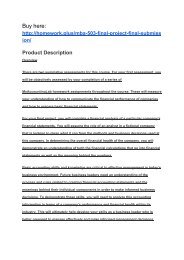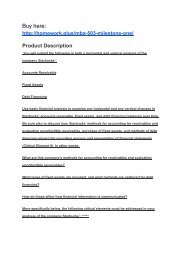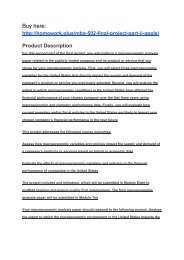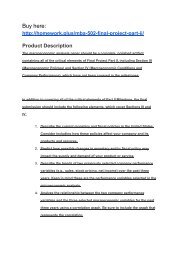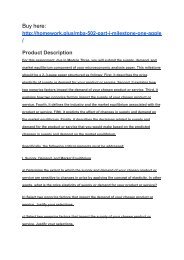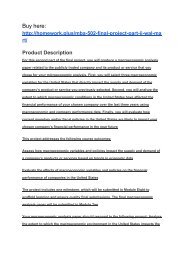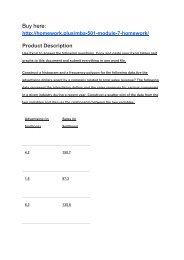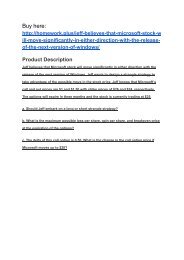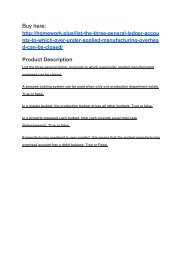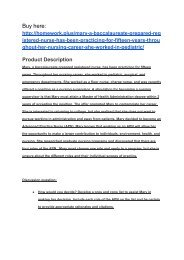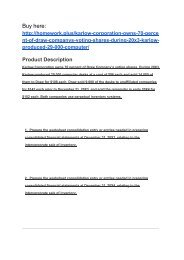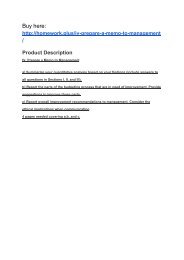IT 330 Final Project Final Project Submission: Database and Report
IT 330 Final Project Final Project Submission: Database and Report
IT 330 Final Project Final Project Submission: Database and Report
You also want an ePaper? Increase the reach of your titles
YUMPU automatically turns print PDFs into web optimized ePapers that Google loves.
Buy here:<br />
http://homework.plus/it-<strong>330</strong>-final-project-final-project-sub<br />
mission-database-<strong>and</strong>-report/<br />
Product Description<br />
<strong>Database</strong>s are increasingly important in the information age, as they provide a means to<br />
organize, track, manage, <strong>and</strong> use information easily <strong>and</strong> efficiently. Thous<strong>and</strong>s of companies<br />
depend on databases to record <strong>and</strong> update data. <strong>Database</strong>s have a wide variety of uses,<br />
from tracking climate measurements worldwide to storing library research information to<br />
organizing user data for businesses <strong>and</strong> organizations<br />
For this assessment, you will solve an information storage problem. The owner of two local<br />
bookstores wants to consolidate individual store inventories. You will organize the store<br />
inventory data into workable tables <strong>and</strong> apply normalization techniques to create a single<br />
common SQL-based database that can be shared between the stores. In addition, you will<br />
submit a report explaining the choices you made in the creation of your database. The report<br />
will also include an entityrelationship diagram <strong>and</strong> other models as well as a description of<br />
the database design features<br />
Some components of this final project will have been developed earlier in the course <strong>and</strong><br />
submitted for instructor feedback. You will submit them a second time as part of this final<br />
project, incorporating the feedback that you received from your instructor. This project is<br />
divided into two milestones, which will be submitted at various points throughout the course<br />
to scaffold learning <strong>and</strong> ensure quality final submissions. These milestones will be due in<br />
Modules Two <strong>and</strong> Four. The final database <strong>and</strong> report will be submitted in Module Seven<br />
This assessment addresses the following course outcomes:<br />
Differentiate between database systems <strong>and</strong> file systems by comparing features <strong>and</strong><br />
functions to determine benefits in data management
Analyze business information storage problems for depicting suitable information model<br />
solutions using entity relation diagrams<br />
Apply database normalization theory to relational data models for defining relationships <strong>and</strong><br />
minimizing redundancy<br />
Develop solutions to query <strong>and</strong> data update problems using a Structured Query Language<br />
interface to create, populate, maintain, <strong>and</strong> query databases<br />
Books’R’Us is a local bookstore that started in 1978 in a small New Engl<strong>and</strong> town.<br />
Books’R’Us has been able to withst<strong>and</strong> the challenges of larger bookstore chains, as well as<br />
the internet giant Amazon.com, by offering new <strong>and</strong> used books <strong>and</strong> other products in a<br />
comfortable location that includes a café with free WiFi. Books’R’Us recently purchased<br />
another local bookstore called Great Books, USA, from an owner who is retiring. Both<br />
businesses use a simple bookkeeping system that includes Microsoft Excel<br />
The owners of Books’R’Us, Tom <strong>and</strong> Sarah Smith, would like a more efficient way to store<br />
inventory data <strong>and</strong> report on the various business essentials. They are also preparing to<br />
offer e-commerce on their website. A consulting firm has recommended capturing<br />
information in a database <strong>and</strong> linking access to the database for each store. Tom <strong>and</strong> Sarah<br />
purchased Microsoft SQL Server to do this. The consulting firm has hired you to complete<br />
the database for Books’R’Us. In addition to creating the database, you will provide a report<br />
for your supervisor at the consulting firm; this report should describe the rationale for <strong>and</strong><br />
proposed development of the database<br />
Imagine that you have interviewed the store owners, Tom <strong>and</strong> Sarah Smith, <strong>and</strong> these are<br />
the questions with which they are most concerned:<br />
1. How many books are sold each month by the publisher? This is important because<br />
quantity discounts are available from the publisher.
2. Which authors are the biggest sellers of books in our stores? This is important because<br />
the publisher offers discounts for certain authors each month.<br />
3. What books are associated with each publisher?<br />
4. What are the most popular products besides books that are sold in each store? In addition<br />
to books, the stores sell magazines, café-specific products like coffee <strong>and</strong> pastries, <strong>and</strong><br />
various gift products.<br />
5. From what region(s) (by ZIP code) do customers visit our stores? This is important<br />
because it will assist with future marketing efforts.<br />
6. What customer data must be stored for the e-commerce portion of the website?<br />
Your database <strong>and</strong> report should answer the following prompt: Create a database that meets<br />
the needs of the store owners. In addition to the database, you will submit a report that<br />
includes several models <strong>and</strong> diagrams that you completed earlier in the course to inform<br />
your database creation; you will resubmit these models <strong>and</strong> diagrams after incorporating<br />
your instructor’s feedback<br />
Specifically, the following critical elements must be addressed:<br />
I. <strong>Database</strong>:<br />
You will use your entity-relationship diagram, relational model, functional dependencies<br />
diagram, <strong>and</strong> functional relational schema to inform the creation of your database. These will<br />
be submitted as part of your report.<br />
A. Tables: Create at least four tables that will display the data that is important to the store<br />
owners. Identify the primary <strong>and</strong> foreign keys that are necessary to relate the tables. Include<br />
screenshots that show the tables you created.
B. Import Data: Use SQL statements to import the data into the tables you just created. You<br />
will come up with each of your data sets yourself. You should have at least five records for<br />
each table. Include screenshots that show the populated tables annotated with the SQL<br />
statements that you used.<br />
C. Queries: After you have populated the tables, write queries to extract the data to answer<br />
the owner’s questions. Include screenshots that show each query <strong>and</strong> the corresponding<br />
query results<br />
II. <strong>Report</strong>:<br />
Although some parts of the report will be completed before or during the creation of the<br />
database, the report as a whole will be written after you have created the database.<br />
A. Overview: Provide a concise overview of the problem you are solving <strong>and</strong> the database<br />
that you created to address the problem.<br />
B. Justification: Analyze the business information storage problem you are solving. Why is<br />
the database the appropriate solution to the problem?<br />
C. Benefits: What benefits in data management does the database you created have over a<br />
file system like the one the stores were previously using? What features <strong>and</strong> functions does<br />
a database have that a file system does not?<br />
D. Features: Describe each of the major features of the database you created. Why are<br />
these features required?<br />
E. Design: How did you design the database to manage the stores’ data? Discuss the tables<br />
you created <strong>and</strong> their relationships, including in your discussion the table name, attributes<br />
(field names <strong>and</strong> data types), <strong>and</strong> keys (primary <strong>and</strong> foreign). Consider including a diagram<br />
to support your response to this question.
F. Entity-Relationship Diagram (ERD): Develop an entity-relationship diagram that has an<br />
appropriate set of attributes for each entity.<br />
G. Relational Model: Develop a relational model that is logical <strong>and</strong> complies with the<br />
requirements in your ERD.<br />
H. Functional Dependencies Diagram: Based on your ERD, develop a functional<br />
dependencies diagram that accurately normalizes the data into third normal form (3NF).<br />
I. Functional-Relational Schema: Based on your ERD <strong>and</strong> dependencies diagram, develop a<br />
relational schema that accurately normalizes the data into 3NF.<br />
Milestone One: <strong>Project</strong> Proposal In Module Two, you will submit a project proposal <strong>and</strong> its<br />
overview as a Word document. This milestone is graded with the Milestone One Rubric<br />
Milestone Two: Systems Analysis In Module Four, you will submit a systems analysis for<br />
your project, including a comprehensive entity-relation diagram (ERD). Although you may<br />
use any tool to complete the ERD, it is strongly recommended that you use Microsoft Visio<br />
<strong>and</strong> then save the diagram into an image format (GIF or JPG) <strong>and</strong> then copy <strong>and</strong> paste the<br />
image into your systems analysis. All sections of this milestone should be compiled into a<br />
single Word document. This milestone is graded with the Milestone Two Rubric<br />
<strong>Final</strong> <strong>Project</strong> <strong>Submission</strong>: <strong>Database</strong> <strong>and</strong> <strong>Report</strong> In Module Seven, you will submit your<br />
database <strong>and</strong> report. Your database <strong>and</strong> report should answer the following prompt: Create<br />
a database that meets the needs of the store owners. In addition to the database, you will<br />
also submit a report that includes several models <strong>and</strong> diagrams that you completed earlier in<br />
the course to inform your database creation; you will now resubmit these models <strong>and</strong><br />
diagrams after incorporating your instructor’s feedback. This submission is graded with the<br />
<strong>Final</strong> <strong>Project</strong> Rubric




